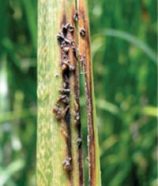Farming on a snail’s scale
Some snails plow leaves and add fertilizer to grow a fungus for dinner.
By Emily Sohn
Certain types of ants, beetles, and termites live like little farmers and grow their own fungus to eat. Now, scientists have discovered a species of snail that does the same thing.
 |
|
This leaf from a salt marsh shows a snail farm, where a snail has cut a slit and deposited droppings to encourage a fungus to grow.
|
| Brian Silliman |
The snail, called Littoraria irrorata, lives in salt marshes on the east coast of the United States. Researchers at Brown University in Providence, R.I., noticed that these snails like to feed on sick and dying cordgrass. Cordgrass is a wiry-looking plant that grows where the ground is wet and salty.
They also noted that, without snails around, the cordgrass appears to be much healthier. Very few plants are infected by fungus.
It turns out that the snails don’t actually eat just cordgrass leaves. Instead, they cut long gashes into the leaves, giving a certain fungus cozy places to start growing. The snails then end up with delicious fungus-enriched meals.
The scientists suspected that the snails are also using their droppings to help the fungus flourish. Indeed, when the researchers added snail droppings to cut leaves, the fungus appeared.
To complete the puzzle, the scientists fed fungus-rich leaves to some snails and undamaged leaves to others. The ones that ate lots of fungus thrived, and most of their babies survived, too. The leaf-fed snails hardly grew, and nearly half of their babies died.
Some researchers are surprised to find farming behavior in snails. Snails aren’t nearly as social as ants and other insects that farm. The discovery might help explain how farming behavior developed in animals.
Don’t expect to see snails on little tractors any time soon, though. Their farming behavior is still pretty primitive.







